 |
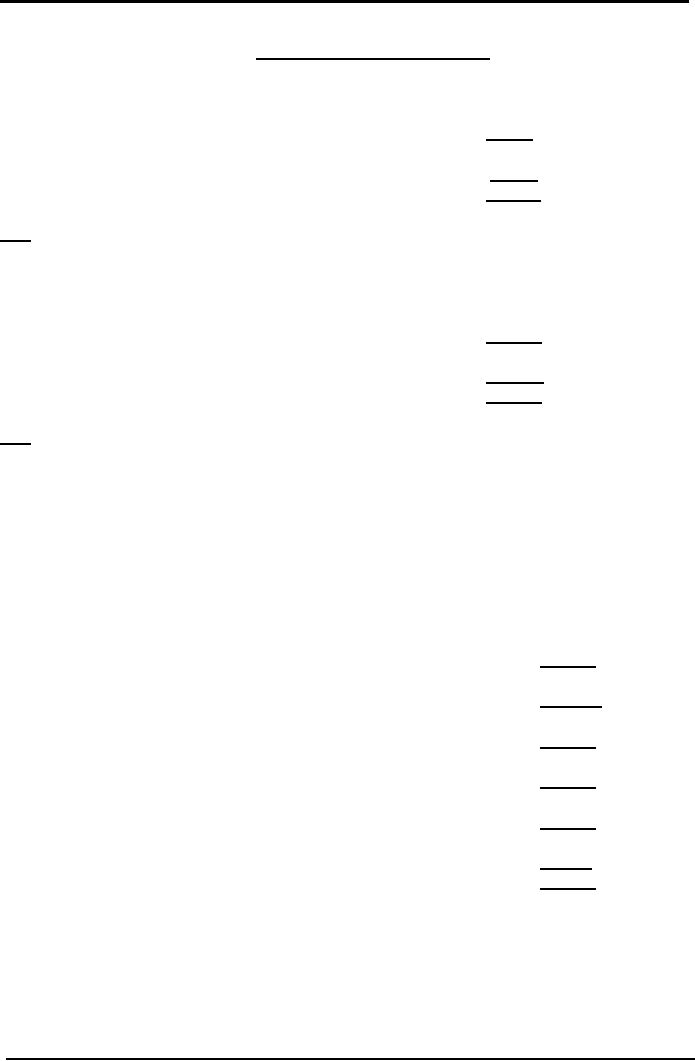
Cost
& Management Accounting
(MGT-402)
VU
LESSON#
4
FINANCIAL
STATEMENTS
Cost
of Goods Manufactured
Rupees
Total
factory Cost
230,000
Add
Opening Work in process
inventory
30,000
Cost
of goods to be manufactured
260,000
Less
Closing Work in process
50,000
Cost
of goods manufactured
210,000
Note:
Cost of the work that was in process in
the last year (Closing WIP
inventory) becomes Opening
WIP
inventory
of the current year.
Cost
of Goods Sold
Cost
of goods manufactured
210,000
Add
Opening finished goods
inventory
100,000
Cost
of goods to be sold
310,000
Less
Closing finished goods
(10,000)
Cost
of goods sold
300,000
Note:
Cost of the goods that were in process in the
last year (closing finished goods
inventory) becomes opening
finished
goods inventory of the current
year.
Standard
format of the cost of goods
manufactured and sold statement:
Entity
Name
Cost
of Goods manufactured statement
for
the year ended_______
Rupees
Direct
Material Consumed
Opening
inventory
10,000
Add
Net Purchases
100,000
Material
available for use
110,000
Less
Closing inventory
(20,000)
Direct
Material used
90,000
Add
Direct labor
60,000
Prime
cost
150,000
Add
Factory overhead Cost
80,000
Total
factory cost
230,000
Add
Opening Work in
process
30,000
Cost
of good to be manufactured
260,000
Less
Closing Work in process
50,000
Cost
of good manufactured
210,000
22
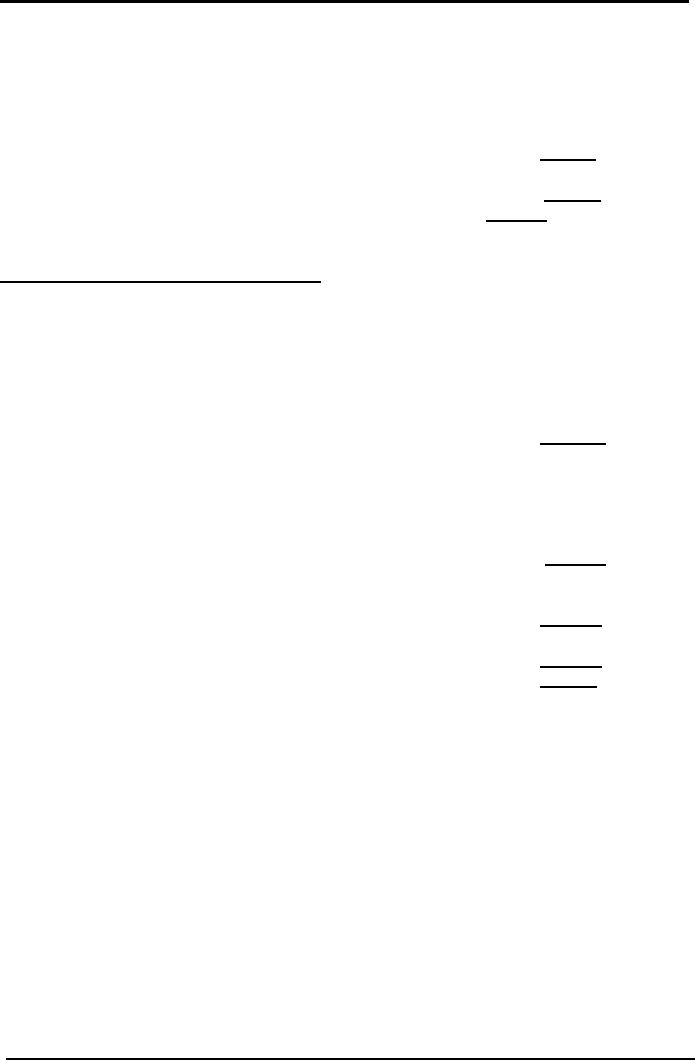
Cost
& Management Accounting
(MGT-402)
VU
Entity
Name
Cost
of goods sold statement
For
the year ended_______
Rupees
Add
Opening finish goods
100,000
Cost
of goods manufactured
210,000
Cost
of good to be sold
310,000
Less
closing finish goods
10,000
Cost
of good to sold
300,000
Standard
format of the Income
Statement:
Entity
Name
Income
Statement
For
the year ended_______
Rupees
Sales
600,000
Less
Cost of goods
sold
(300,000)
Gross
profit
300,000
Less
Operating expenses
Selling
and marketing
50,000
Distribution
30,000
Administrative
20,000
(100,000)
Operating
profit
200,000
Less
Financial Expenses
Interest
on loan
(50,000)
Profit
before tax
150,000
Less
Income Tax
(60,000)
Net
profit
90,000
Applied
Factory Overhead Cost
Often
at the end of the accounting
period total FOH cost is not
known in actual because of
the
specified
nature of expenses in the
list of indirect
cost.
For
this reason, the third
element of cost "FOH" is included in the
total factory cost based
on
predetermined
FOH cost rate; such cost is
known as Applied FOH
Cost.
Predetermined
(FOH cost) rate
Factory
overhead rate is determined on the
basis of normal activity
level. Normal activity
level
means
the capacity level at which
the business can operate in
normal circumstances.
Capacity
level
can be in terms of:
Direct
Labor Cost
Direct
Material Cost
Direct
Labor Hours
Machine
Hours
Prime
Cost
23
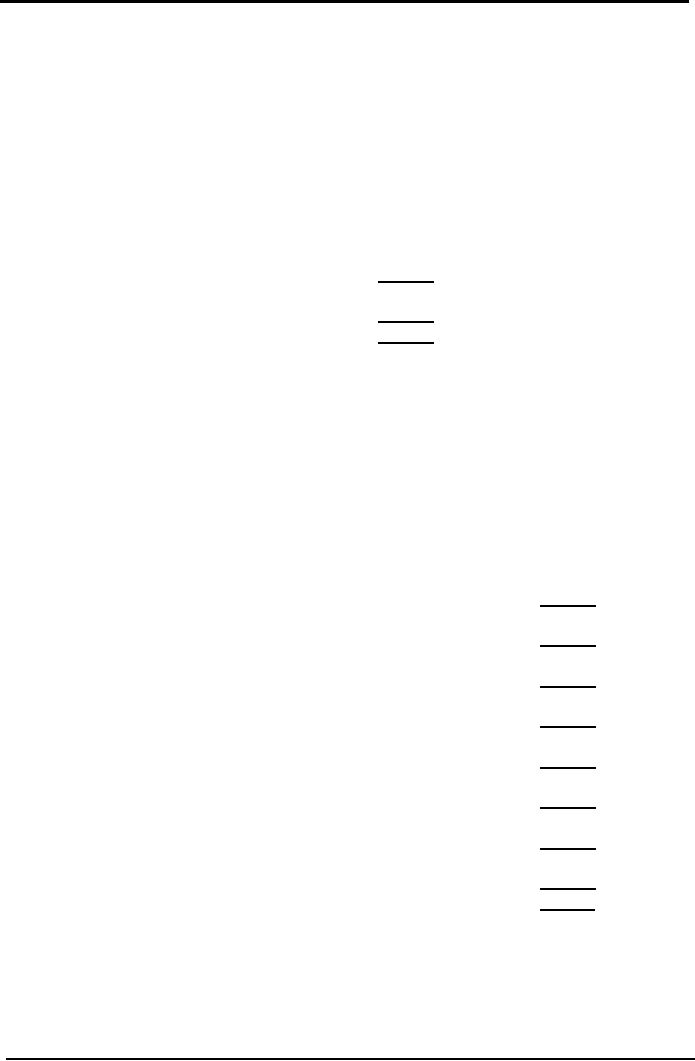
Cost
& Management Accounting
(MGT-402)
VU
Selection
of capacity level depends
upon the nature of the
business, if its inclination is
towards
machine
hours then machine hours
will be taken as a base as capacity
level. It is also known
as
overhead
absorption rate
(OAR).
Calculations
pertaining to the overhead application
rate will not be discussed
here, in this
chapter
we will use pre-calculated overhead
application rate.
Details
of the topic will be covered
in a LESSON relating to Factory Over
Head.
Total
Factory Cost based on Applied FOH
Cost
Assume
applied factory overhead rate is
150% of direct labor
cost.
Rupees
Direct
material Consumed
90,000
Add
Direct labor
60,000
Prime
Cost
150,000
FOH
Applied (150%
of Rs. 60,000)
90,000
Total
Factory Cost
240,000
The
cost of goods sold in which
factory overhead cost is
included on the basis
of
predetermined
rate is termed as "Cost of Goods
Sold at Normal"
Entity
Name
Cost
of Goods Sold statement
At
normal
for
the year ended_______
Rupees
Direct
Material Consumed
Opening
inventory
10,000
Add
Net Purchases
100,000
Material
available for use
110,000
Less
Closing inventory
20,000
Direct
Material used
90,000
Add
Direct labor
60,000
Prime
cost
150,000
Add
Factory overhead Cost
(60,000
x 150%)
90,000
Total
factory cost
240,000
Add
Opening Work in
process
30,000
Cost
of good to be manufactured
270,000
Less
Closing Work in process
50,000
Cost
of good manufactured
220,000
Add
Opening finish goods
100,000
Cost
of good to be sold
320,000
Less
closing finish goods
10,000
Cost
of good to sold at
normal
310,000
Variance
Difference
between the actual cost
and applied cost is
calculated by subtracting actual
cost from
the
applied cost. Where the
applied cost is greater than
the actual cost it is favorable
variance,
but
where the applied cost is
lesser than the actual
cost it is unfavorable
variance.
24
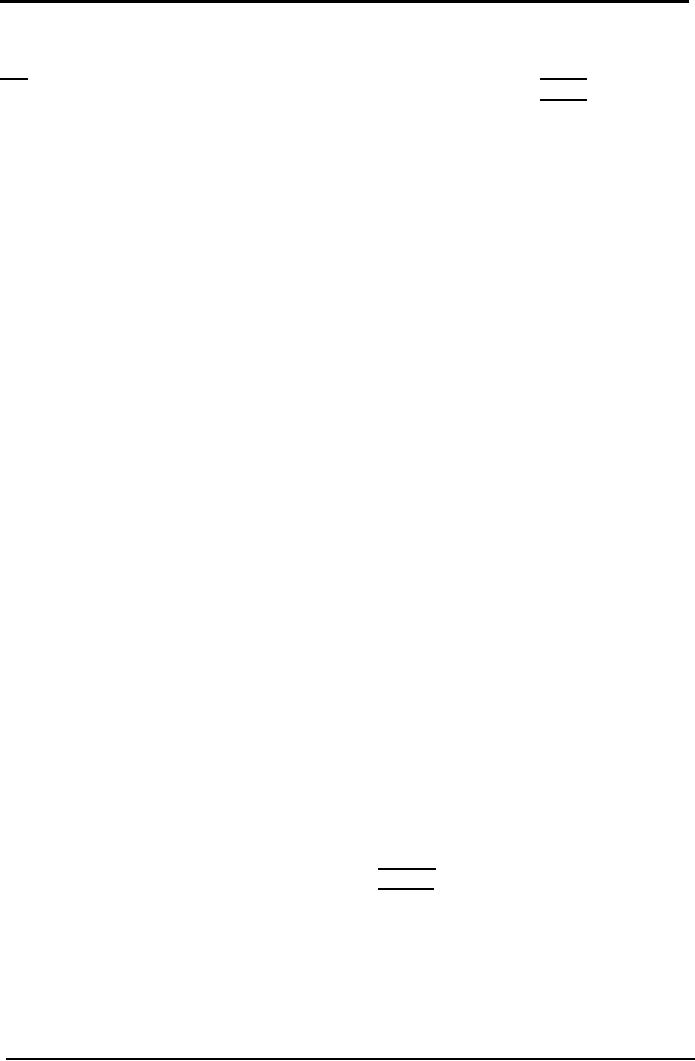
Cost
& Management Accounting
(MGT-402)
VU
Under/Over
applied FOH cost
Applied
FOH Cost
90,000
Less
Actual
FOH Cost
80,000
Over
applied FOH cost
10,000
Adjustment
of Under/Over applied FOH cost
Such
variance should be eliminated form
the financial statements
through adjustment.
Under/Over
applied FOH cost can be
adjusted in following costs/profit
figures:
1.
Entire Production
a)
work
in process inventory
b)
finished
goods inventory
c)
cost
of goods sold
2.
Cost of Goods
Sold
3.
Net profit
Adjustment
in the Entire Production
Work
in process Cost
(50,000
- 1,350)
48,650
Finished
goods Cost
(10,000
- 270)
9,730
Cost
of goods sold
(310,000
- 8,380)
301,620
The
concept of addition to and subtraction
from the relevant amount is
that because there is a
favorable
variance i.e. the applied
factory overhead cost is
more than the actual
cost therefore,
to
make correction in the
information containing cost
items (entire production)
there must be
subtraction
equal to the amount which
was over added.
Obviously
the difference will be added
if there is an unfavorable variance
i.e. the applied
factory
overhead
cost is less than the
actual cost. This is so
because the cost charged is
lesser than the
actual,
and to make the cost
items (entire production)
equal to their actual figures we
need
inclusion
of further amount.
Entire
production includes three items;
work in process inventory,
finished goods
inventory,
and
cost of goods sold. These
three items are the
three parts in which total
cost of production
(either
finished or semi finished)
has been divided.
Adjustment
in the Cost of Goods
Sold
Some
times it is required to adjust all of the
variance in the cost of
goods sold, here the
same
principle
of addition or subtraction will be
followed which has already
been discussed in the
above
paragraphs. This is so because
the cost of goods sold is
also a cost item. The
amount of
cost
of goods sold before adjustment is known
as cost of goods sold at normal
and after
adjustment
is known cost of goods sold at
actual.
Cost
of goods sold at normal
310,000
Add
over applied FOH
(10,000)
Cost
of goods sold at actual
300,000
25
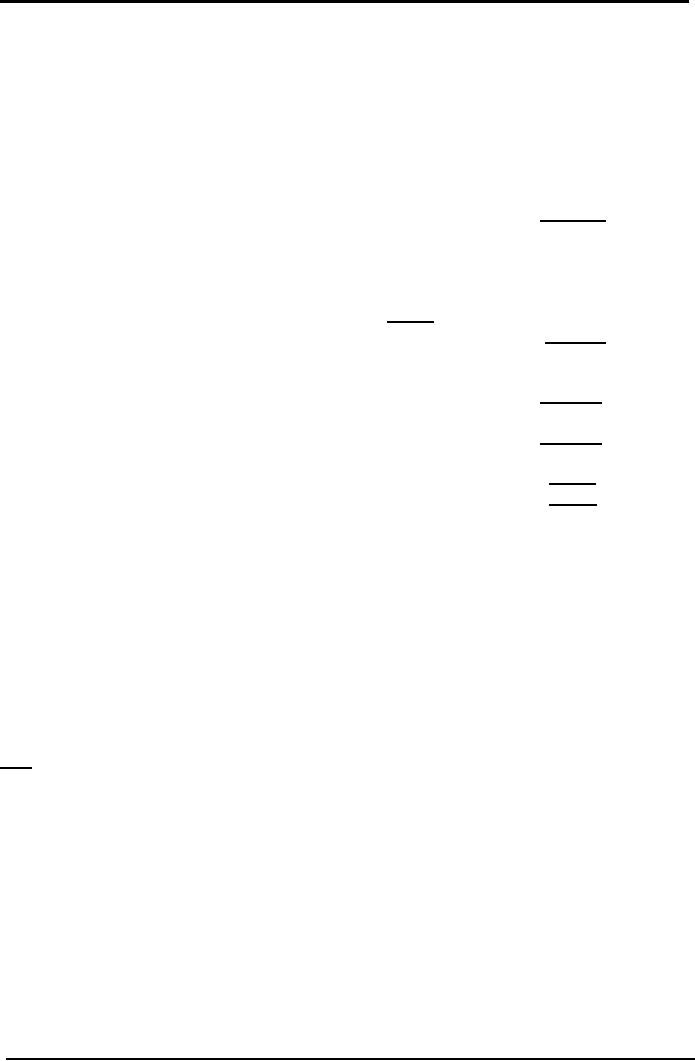
Cost
& Management Accounting
(MGT-402)
VU
Adjustment
in the Income Statement
Entity
Name
Income
Statement
Based
on applied FOH cost
For
the year ended_______
Rupees
Sales
600,000
Less
Cost of goods sold (at
normal)
(310,000)
Gross
profit
290,000
Less
Operating expenses
Selling
and marketing
50,000
Distribution
30,000
Administrative
20,000
(100,000)
Operating
profit
190,000
Less
Financial Expenses
Interest
on loan
(50,000)
Profit
before tax
140,000
Less
Income Tax
(60,000)
Net
profit
80,000
Add
over-applied FOH cost
10,000
Net
profit
90,000
Principle
of addition or subtraction of factory
overhead variance is reverse in income
statement.
This
is so because here the
amount of net profit is
adjusted for the variances,
which is income in
nature.
Over-application
of factory overhead cost
causes an increase in the
cost of goods sold
which
reduces
the gross profit and
also the net profit, so to
bring the amount of net
profit at its actual
amount
we need to add over-applied factory
overhead cost in the net
profit. Obviously in case
of
under
application of factory over head
cost the variance will be
subtracted from the amount of
net
profit.
PRACTICE
QUESTIONS
Following
data relates to Qasim &Co,
Q.
1
Rupees
Opening
stock of raw material
52,000
Opening
stock of work in process
46,000
Purchases
of raw material
255,000
Direct
labor cost
85,000
Factory
overheads
76,000
Closing
stock of raw material
61,000
Closing
stock of work in process
36,000
Required:
Prepare
Cost of Goods Manufactured
Statement.
26
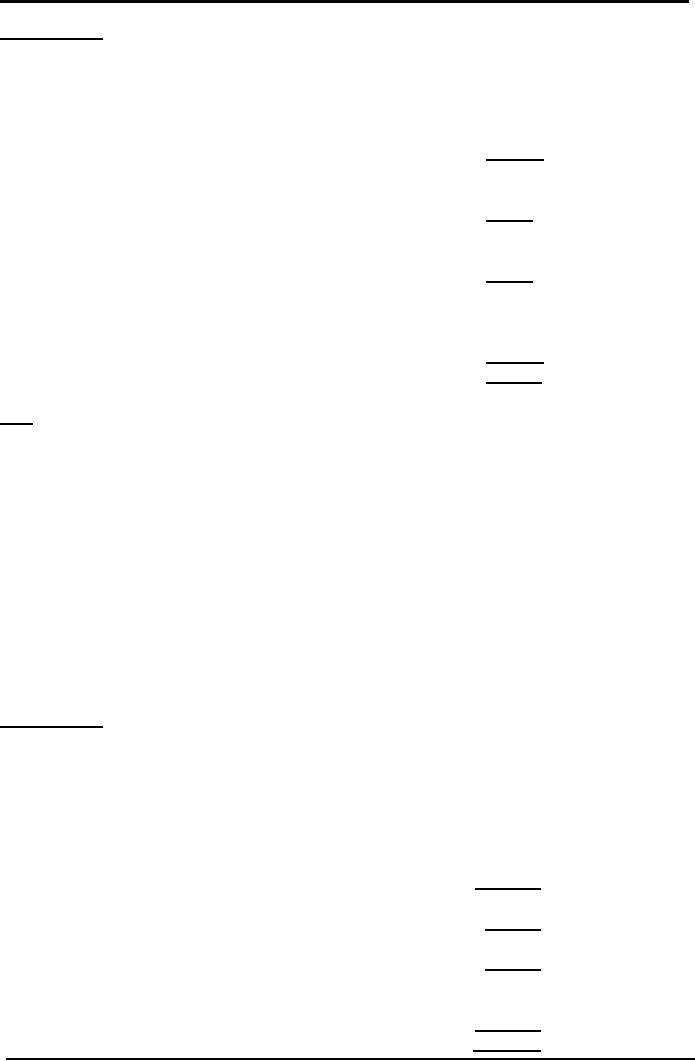
Cost
& Management Accounting
(MGT-402)
VU
SOLUTION:
Qasim
& Co.
Cost
of goods manufactured statement
Rupees
Opening
stock of raw material
52,000
Add:
Purchases of raw material
255,000
Less:
Closing stock of raw material
(61,000)
Cost
of raw material consumed
246,000
Add:
Direct labor cost
85,000
Prime
cost/Direct cost
331,000
Add:
Factory overheads
76,000
Manufacturing
cost/Factory cost
407,000
Add:
Opening stock of work in
process
46,000
Less:
Closing stock of work in process
(36,000)
Cost
of goods manufactured
417,000
Q.
4
Ayesha
Products Limited purchased materials of
Rs. 440,000 and incurred
direct labor of
Rs.
320,000 during the year
ended June 30, 2006.
Factory overheads for the
year were Rs.280,000.
The
inventory balances are as
follows:
July
1, 2005
June
30, 2006
Rupees
Rupees
Finished
goods
90,000
105,000
Work
in process
121,000
110,000
Materials
100,000
105,000
Required:
1)
Cost
Of Goods Manufactured
Statement.
2)
Cost
Of Goods Sold
Statement.
SOLUTION:
1)
Ayesha
Products Limited
Cost
of goods manufactured statement
For
the year ended June 30,
2006
Materials
inventory, July 1
2005
100,000
Add:
purchases of materials
440,000
Less:
materials inventory, June
30, 2006
(105,000)
Cost
of materials consumed
435,000
Add:
direct labor
320,000
Prime
cost/Direct cost
755,000
Add:
factory overheads
280,000
Manufacturing
cost/Factory cost
1,035,000
Add:
Inventory of work in process,
July 1, 2005
121,000
Less:
Inventory of work in process,
June 30, 2006
(110,000)
Cost
of goods manufactured
1,046,000
27
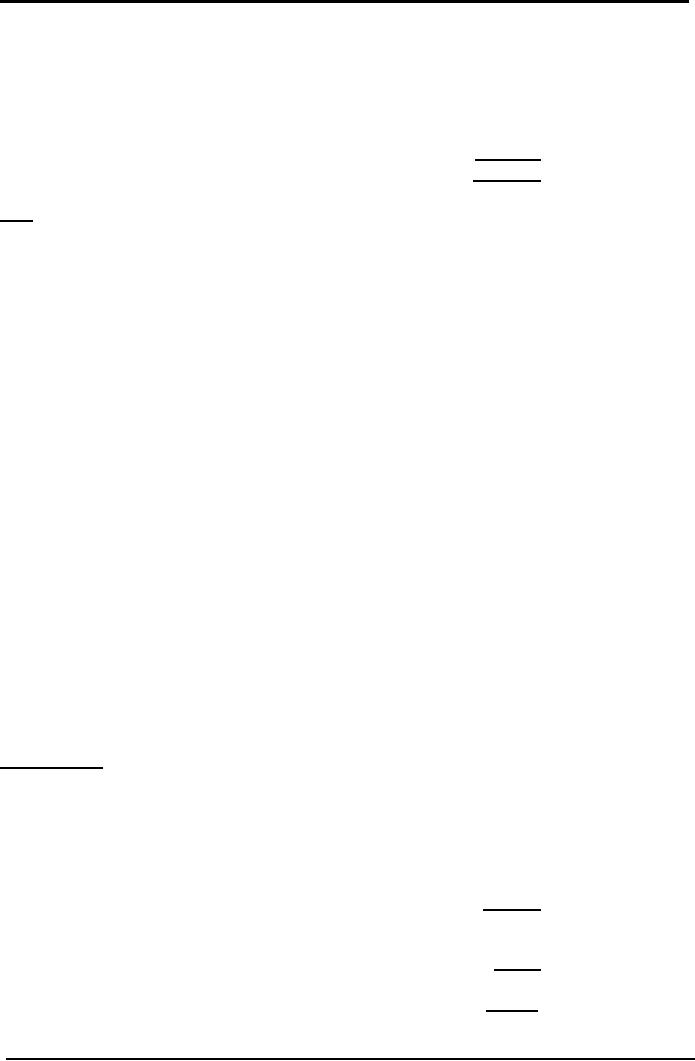
Cost
& Management Accounting
(MGT-402)
VU
2)
Ayesha
Products Limited
Cost
of goods sold statement
For
the year ended June 30,
2006
Cost
of goods manufactured
1,046,000
Add:
inventory of finished goods,
July 1, 2005
90,000
Less:
inventory of finished goods,
June 30, 2006
(105,000)
Cost
of goods sold
1,031,000
Q.
5
FNS
manufacturing company submits the
following information on June
30, 2005.
Sales
for the year
450,000
Raw
material inventory, July 1,
2004
15,000
Finished
goods inventory, July 1,
2004
70,000
Purchases
120,000
Direct
labor
65,000
Power,
heat and light
2,500
Indirect
material purchased and consumed
4,500
Administrative
expenses
21,000
Depreciation
of plant
14,000
Selling
expenses
25,000
Depreciation
of building
7,000
Bad
debts
1,500
Indirect
labor
3,000
Other
manufacturing expenses
10,000
Work
in process, July 1,
2004
14,000
Work
in process, June 30,
2005
19,000
Raw
materials inventory, June
30, 2005
21,000
Finished
goods inventory, June 30,
2005
60,000
Applied
factory head rate is 20% of
the prime cost
Required
1)
Cost
Of Goods Manufactured
Statement.
2)
Cost
Of Goods Sold Statement at
normal and at actual
3)
Income
statement.
SOLUTION:
FNS
manufacturing company
Cost
of goods manufactured statement
For
the year ended June 30,
2005
Raw
materials inventory, July 1
2004
15,000
Add:
purchases of materials
120,000
Less:
materials inventory, June
30, 2005
(21,000)
Cost
of materials consumed
114,000
Add:
direct labor
65,000
Prime
cost/Direct cost
179,000
Factory
overhead applied
(179,000x20%)
35,800
Manufacturing
cost/Factory cost
214,800
Add:
Inventory of work in process,
July 1, 2005
14,000
28
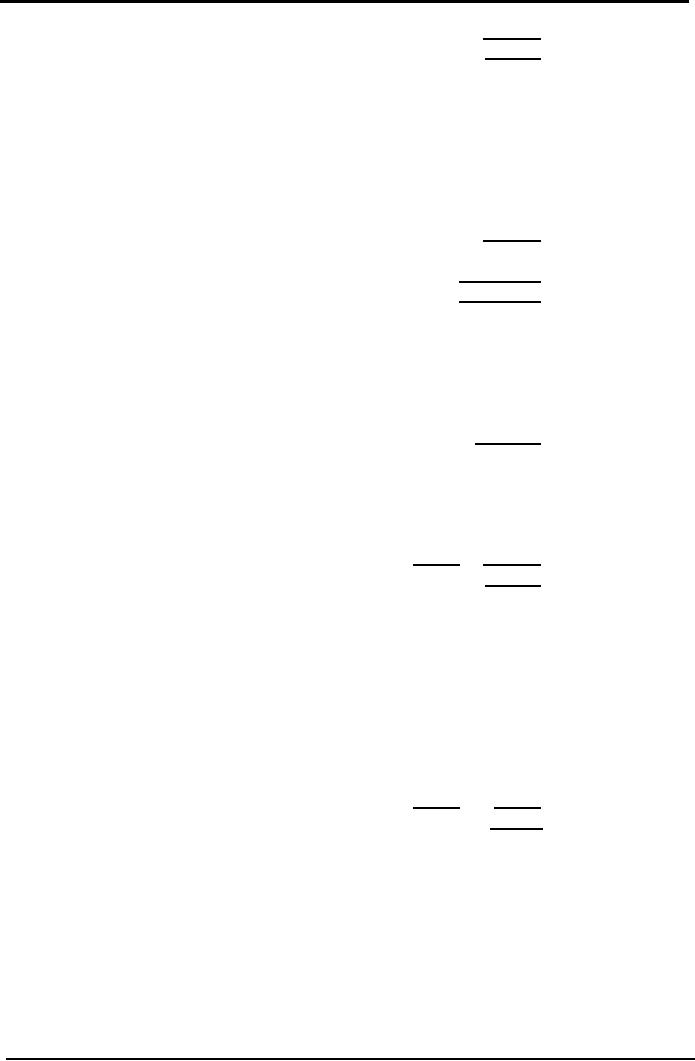
Cost
& Management Accounting
(MGT-402)
VU
Less:
Inventory of work in process,
June 30, 2006
(19,000)
Cost
of goods manufactured
209,800
2)
FNS
manufacturing company
Cost
of goods sold statement
For
the year ended June 30,
2006
Cost
of goods manufactured
209,800
Add:
inventory of finished goods,
July 1, 2004
70,000
Less:
inventory of finished goods,
June 30, 2005
(60,000)
Cost
of goods sold at normal
219,800
Less:
over-applied factory overhead
(working)
1,800
Cost
of goods sold at actual
218,000
3)
FNS
manufacturing company
Income
statement
For
the year ended June 30,
2006
Sales
450,000
Less:
cost of goods sold
(218,000)
Gross
profit
232,000
Less:
operating expenses
Bad
debts
1,500
Depreciation
of building
7,000
Selling
expenses
25,000
Administrative
expenses
21,000
(54,500)
Net
profit
177,500
Working
Applied
factory overhead cost
35,800
Actual
factory overheads
Power,
heat and light
2,500
Indirect
material purchased and consumed
4,500
Depreciation
of plant
14,000
Indirect
Labor
3,000
34,000
Other
manufacturing expenses
10,000
Over-applied
factory overhead
1,800
29
Table of Contents:
- COST CLASSIFICATION AND COST BEHAVIOR INTRODUCTION:COST CLASSIFICATION,
- IMPORTANT TERMINOLOGIES:Cost Center, Profit Centre, Differential Cost or Incremental cost
- FINANCIAL STATEMENTS:Inventory, Direct Material Consumed, Total Factory Cost
- FINANCIAL STATEMENTS:Adjustment in the Entire Production, Adjustment in the Income Statement
- PROBLEMS IN PREPARATION OF FINANCIAL STATEMENTS:Gross Profit Margin Rate, Net Profit Ratio
- MORE ABOUT PREPARATION OF FINANCIAL STATEMENTS:Conversion Cost
- MATERIAL:Inventory, Perpetual Inventory System, Weighted Average Method (W.Avg)
- CONTROL OVER MATERIAL:Order Level, Maximum Stock Level, Danger Level
- ECONOMIC ORDERING QUANTITY:EOQ Graph, PROBLEMS
- ACCOUNTING FOR LOSSES:Spoiled output, Accounting treatment, Inventory Turnover Ratio
- LABOR:Direct Labor Cost, Mechanical Methods, MAKING PAYMENTS TO EMPLOYEES
- PAYROLL AND INCENTIVES:Systems of Wages, Premium Plans
- PIECE RATE BASE PREMIUM PLANS:Suitability of Piece Rate System, GROUP BONUS SYSTEMS
- LABOR TURNOVER AND LABOR EFFICIENCY RATIOS & FACTORY OVERHEAD COST
- ALLOCATION AND APPORTIONMENT OF FOH COST
- FACTORY OVERHEAD COST:Marketing, Research and development
- FACTORY OVERHEAD COST:Spending Variance, Capacity/Volume Variance
- JOB ORDER COSTING SYSTEM:Direct Materials, Direct Labor, Factory Overhead
- PROCESS COSTING SYSTEM:Data Collection, Cost of Completed Output
- PROCESS COSTING SYSTEM:Cost of Production Report, Quantity Schedule
- PROCESS COSTING SYSTEM:Normal Loss at the End of Process
- PROCESS COSTING SYSTEM:PRACTICE QUESTION
- PROCESS COSTING SYSTEM:Partially-processed units, Equivalent units
- PROCESS COSTING SYSTEM:Weighted average method, Cost of Production Report
- COSTING/VALUATION OF JOINT AND BY PRODUCTS:Accounting for joint products
- COSTING/VALUATION OF JOINT AND BY PRODUCTS:Problems of common costs
- MARGINAL AND ABSORPTION COSTING:Contribution Margin, Marginal cost per unit
- MARGINAL AND ABSORPTION COSTING:Contribution and profit
- COST – VOLUME – PROFIT ANALYSIS:Contribution Margin Approach & CVP Analysis
- COST – VOLUME – PROFIT ANALYSIS:Target Contribution Margin
- BREAK EVEN ANALYSIS – MARGIN OF SAFETY:Margin of Safety (MOS), Using Budget profit
- BREAKEVEN ANALYSIS – CHARTS AND GRAPHS:Usefulness of charts
- WHAT IS A BUDGET?:Budgetary control, Making a Forecast, Preparing budgets
- Production & Sales Budget:Rolling budget, Sales budget
- Production & Sales Budget:Illustration 1, Production budget
- FLEXIBLE BUDGET:Capacity and volume, Theoretical Capacity
- FLEXIBLE BUDGET:ANALYSIS OF COST BEHAVIOR, Fixed Expenses
- TYPES OF BUDGET:Format of Cash Budget,
- Complex Cash Budget & Flexible Budget:Comparing actual with original budget
- FLEXIBLE & ZERO BASE BUDGETING:Efficiency Ratio, Performance budgeting
- DECISION MAKING IN MANAGEMENT ACCOUNTING:Spare capacity costs, Sunk cost
- DECISION MAKING:Size of fund, Income statement
- DECISION MAKING:Avoidable Costs, Non-Relevant Variable Costs, Absorbed Overhead
- DECISION MAKING CHOICE OF PRODUCT (PRODUCT MIX) DECISIONS
- DECISION MAKING CHOICE OF PRODUCT (PRODUCT MIX) DECISIONS:MAKE OR BUY DECISIONS